| Article ID | Journal | Published Year | Pages | File Type |
|---|---|---|---|---|
| 10624075 | Ceramics International | 2016 | 37 Pages |
Abstract
Two bioactive glasses with different chemical compositions (mol%) 46.2SiO2-26.9CaO-24.3Na2O-2.6P2O5 (45S5) and 40SiO2-54CaO-6P2O5 (A2) were synthesized by the use of sol-gel and melt-quenching techniques. The effect of synthesis method on glass structure was investigated using X-ray diffraction, FTIR, Raman, XPS, 29Si and 31P MAS-NMR spectroscopic methods. The results show that the synthesis route has significant influence on the glass structure. Both melt-derived A2 and 45S5 glasses exhibit fully amorphous structure, while gel-derived ones, stabilised at 700 °C, reveal the presence of crystalline silicate and phosphate phases. Gel-derived glasses exhibit more polymerized structure compared to melt-quenched ones. Phosphorus is present in the orthophosphate type environment (Q0) together with some pyrophosphate (Q1) species and it does not take part in the formation of Si-O-P bonds. This indicates that phosphorus acts as a glass structure modifier and forms phosphate-rich phase separated from a silica-rich one. The theoretically predicted network connectivity is consistent with the experimental determination only for melt-derived glasses, assuming silicon as the only network former.
Related Topics
Physical Sciences and Engineering
Materials Science
Ceramics and Composites
Authors
Michal Dziadek, Barbara Zagrajczuk, Piotr Jelen, Zbigniew Olejniczak, Katarzyna Cholewa-Kowalska,
